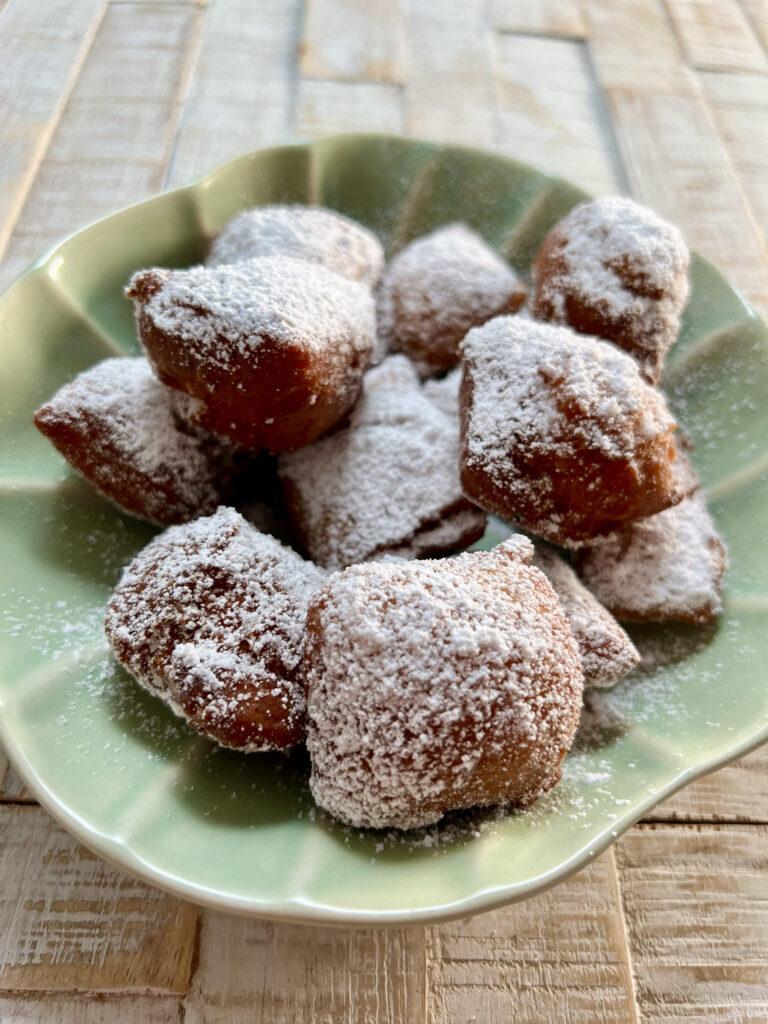
Today, I want to share a recipe from the Christmas season. This is a vegan Schmalzgebäck recipe, a vegan spin on a German Christmas classic. It’s the first time to feature the cooking skills of my mom on LetsGoTomato! So, a warm welcome and a round of applause for mom, please!
In Germany, we have a little puff pastry that totally captures the Christmas vibe for me: They are called Schmalzgebäck, Schmalzkuchen, or Mutzen, depending on in which region of Germany you are. But all these are just different names to describe the most delicious Christmas pastry ever. Probably the best comparison I can make is that they unite characteristics of crullers and doughnuts, but they are just something else. Schmalzgebäck is a soft, fluffy puff pastry generously dusted in powdered sugar. They are simple but amazing.
In Germany, you will find these puff pastries as a fare food on our Christmas markets all over the country for the whole month of December. As “Schmalzgebäck” would directly translate to lard pastry, it’s a sad but not surprising attribute that they are not vegan.
But this is where my mum comes in, as she made a vegan version of this Christmas classic, customized to my family’s liking. If you want to give this German Christmas classic a try, let’s jump right in with this vegan Schmalzgebäck recipe.
Ingredients for Vegan Schmalzgebäck:
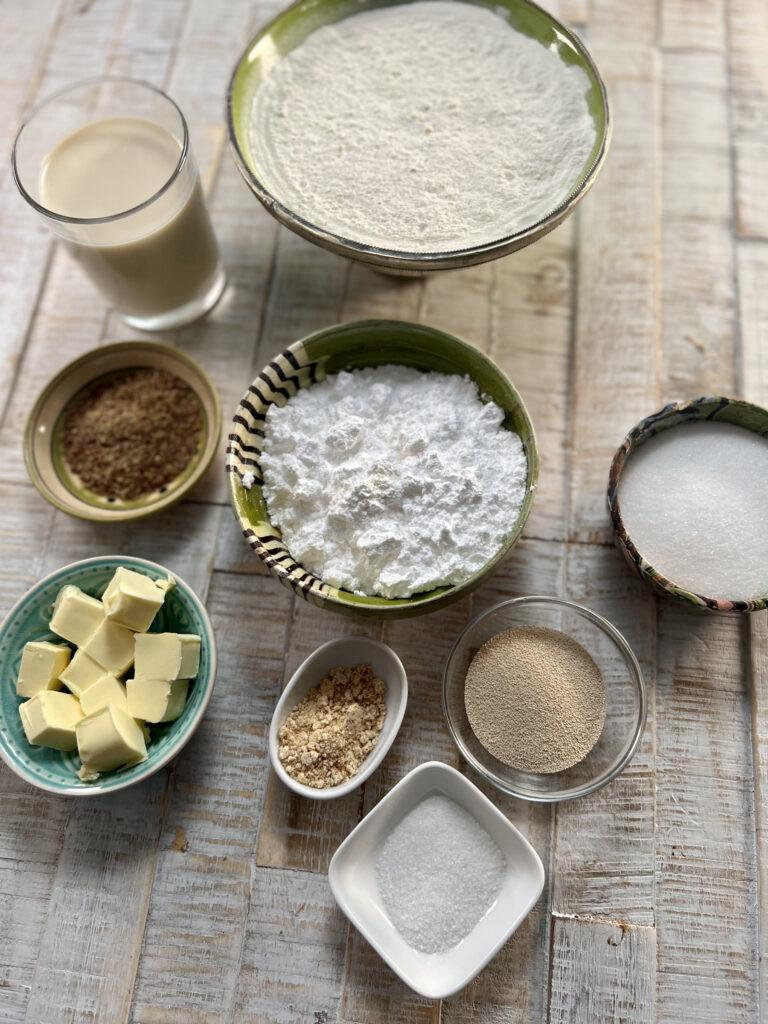
- All-purpose flour
- Yeast
- Sugar
- Vanilla sugar
- Vegan butter substitute
- Salt
- Lemon
- Milk substitute (Oat milk)
- Ground flaxseeds
- Frying oil
Firstly, you will need all-purpose wheat flour. To make the dough nice and fluffy, we use yeast. You can use dry or fresh yeast for this recipe. Other dry ingredients for the dough are sugar, a pack of vanilla sugar, a vegan butter substitute, a pinch of salt and the zest of one organic lemon. Furthermore, you will need a milk substitute of your choice, and I can recommend using oat milk for this recipe. To bind the batter together, we used finely ground flaxseeds and water. While traditionally eggs are used, flaxseed egg works fantastic too. While the dough looks a bit different from the traditional recipe because of the flaxseed, we absolutely didn’t mind the look from the ground flaxseed. You won’t really see a difference after frying them, and you won’t notice it when you eat them!
Vegan Schmalzgebäck Recipe:
Preparing the Dough
Firstly, we want to prepare our egg for the batter: Add the flaxseed flour to a glass, and add three times the volume in warm water. You can make the flaxseed flour yourself by crushing flaxseeds with a pestle and mortar as finely as possible. Let them rest and soak for at least 20 minutes, and give them a mix every once in a while.
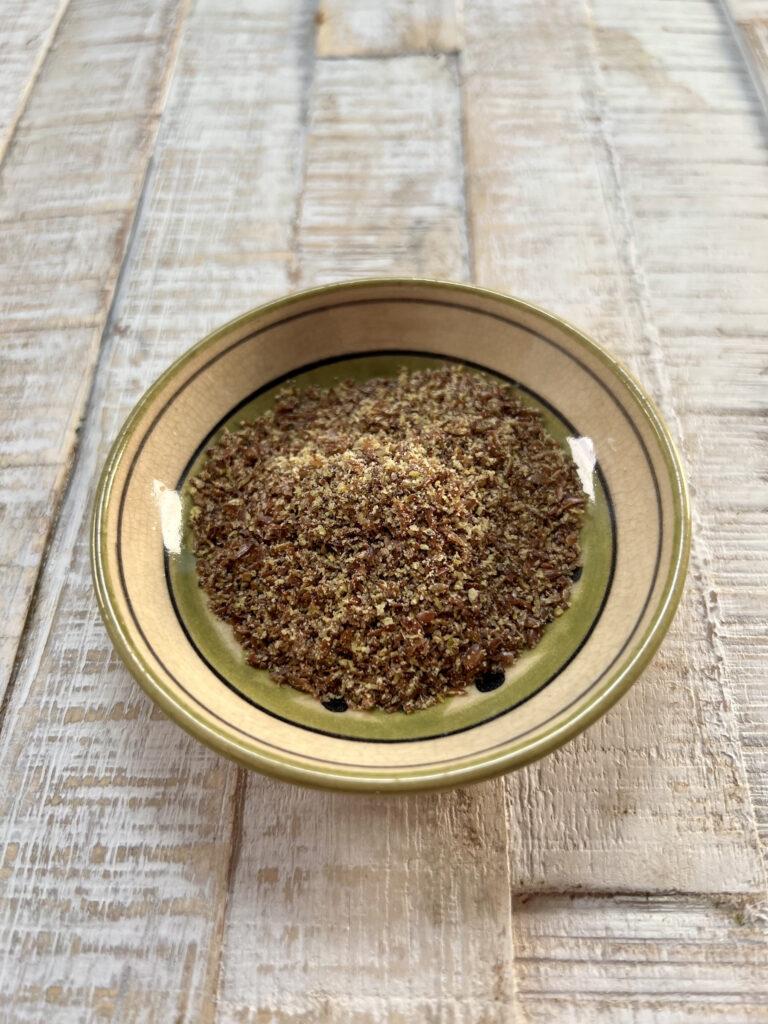
To get a nice, fluffy dough, we want to get started by activating the yeast. You want to be careful when doing so – yeast doesn’t like it if it’s too cold or hot. Start by dissolving the sugar and vanilla sugar in the lukewarm milk, and then add the yeast. The best temperature for that is approximately 32° celsius or 89.6° Fahrenheit. Temperatures above 45° celsius or 113° Fahrenheit will damage or destroy the yeast. Gently mix in the yeast, and wait until some bubbles are forming.
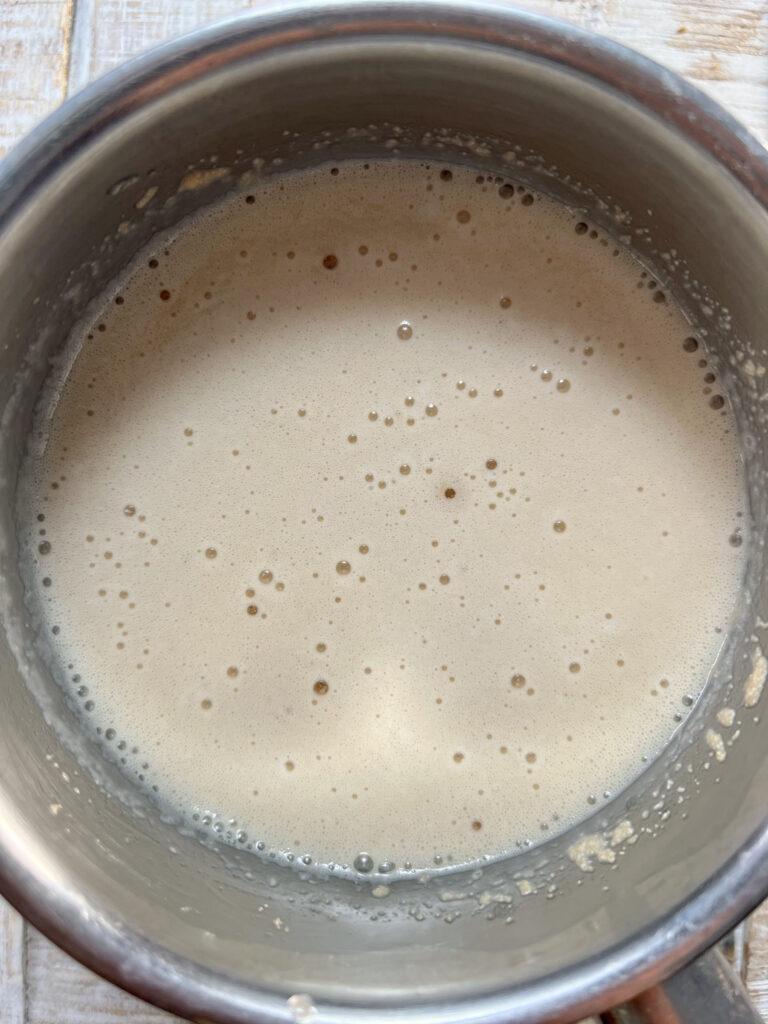
While the bubbles are forming, you can proceed to melt your butter substitute. We don’t need the butter to get really hot, this should just ease incorporating it into the dough. Add the flour, molten butter substitute, and flaxseed egg. Next, grate in the zest of your lemon, add a pinch of salt and knead everything together nicely. My mom did this by hand, but you can use a kitchen appliance for this as well. Don’t worry if the dough looks a bit on the dry side.

Letting the Schmalzgebäck Dough Rest:
Cover the bowl with a clean, wet kitchen towel. Let the dough rest and rise at a warm place for about 45 minutes.
After 45 minutes, the dough should look nice and fluffy. Spread some flour on your kitchen surface, and spread the dough into an equally thick rectangle of approximately 1 cm thickness. You can use a rolling pin or do this by hand. Take a kitchen knife, and cut the dough into equal rhombus-shaped pieces.
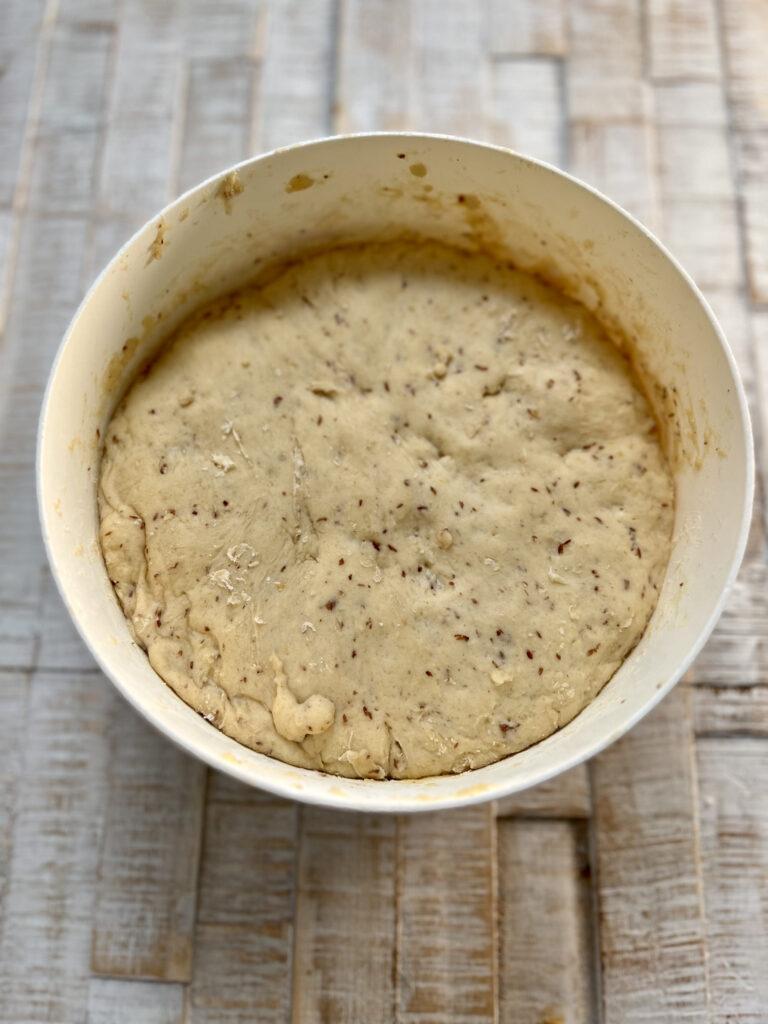
Frying the Vegan Schmalzgebäck:
Heat your frying oil in a pot. We used just half a litre of oil in a small pot because we snacked the Schmalzgebäck fresh and warm in multiple batches throughout the afternoon. You can also use more oil and a larger pot to fry more pieces at a time. To test if your oil has the right temperature stick a wooden toothpick in. If small bubbles are forming around the toothpick, you are ready to go!
You can now fry the dough. It should puff up nicely. Turn the pieces around after 1-2 minutes, to equally fry on both sides. Usually, they are eaten when having a golden colour, but we like to fry them a little bit longer. They are just as puffy and soft, but the outer layer has a better bite. You can try both, and see what you like more. When you take them out of the oil, allow them to rest a bit on a paper towel.
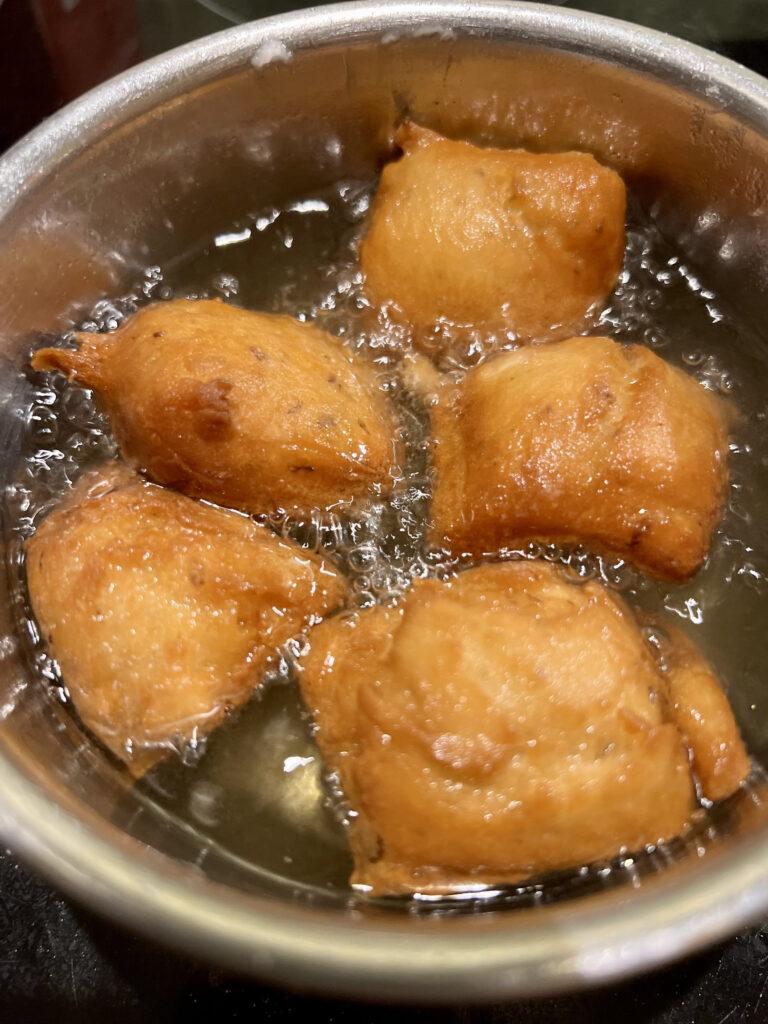
Serving the Vegan Schmalzgebäck:
You can then add your powdered sugar to a sieve and give them a generous dusting. Here, we follow the simple rule: More is more! They are best when enjoyed warm. This is also why we fried the dough in batches. In theory, you can rewarm them in the oven, but freshly fried is definitely the way to go!

Hope you guys like this German Christmas treat! Let us know what you think, and enjoy! Also, sorry for posting this recipe with a bit of a delay. With this dish, my family and I take timing not too seriously! These puff pastries taste delicious not just around Christmas. We like to make and eat them during all of winter. And now that we got this recipe down, perhaps even during the rest of the year as well!
Some more Recipe Inspirations:
- You might like to give these German baked apples a look! They are a treat!
- These vegan shortbread cookies are perfect for Christmas.
- Another classic German Christmas side is braised red cabbage with apples.
- This vegan banana bread recipe is a classic for a reason.
- Vanillekipferl are another Christmas classic here in Germany.
- Sweet pull apart bread is perfect for Easter holidays.
Warm Drinks for Cold Days:
- This spicy orange mint tea will warm you during winter!
- Hot spiced apple juice is coziness in a cup.
- Black tea with sage is simple and delicious.
Vegan German Schmalzgebäck
Course: Dessert, SnacksCuisine: GermanDifficulty: Medium6
servings30
minutes20
minutes45
minutesSchmalzgebäck is a delicious german Christmas puff pastry. I hope you like this vegan recipe!
Ingredients
500g wheat flour
25g yeast
200ml oat milk
80g sugar
8g pack vanilla sugar
1 organic lemon
50 plant-based butter
1 pinch salt
80g powdered sugar
2 tbsp ground flaxseed
6 tbsp warm water
500ml – 1l of frying oil
Directions
- Add the flaxseed flour to a glass, and 6 tbsp of warm water. Let them soak for 20 minutes and give them a stir every once in a while.
- Start by dissolving the sugar and vanilla sugar in the lukewarm milk, and then add the yeast. The best temperature for that is approximately 32° celsius or 89.6° Fahrenheit. Gently mix in the yeast, and wait until some bubbles are forming.
- Proceed to melt your butter substitute. We don’t need the butter to get really hot, this should just ease incorporating it into the dough. Add the flour, molten butter substitute, and flaxseed egg. Next, grate in the zest of your lemon, add a pinch of salt and knead everything together nicely.
- Cover the bowl with a clean, wet kitchen towel. Let the dough rest and rise at a warm place for about 45 minutes.
- Spread some flour on your kitchen surface, and spread the dough into an equally thick rectangle of approximately 1 cm thickness. Take a kitchen knife, and cut the dough into equal rhombus-shaped pieces.
- Heat your frying oil in the pan. You want some small bubbles to form if you stick a toothpick in. You can now fry the dough. Turn the pieces around after 1-2 minutes, to equally fry on both sides.
- When you take them out of the oil, allow them to rest a bit on a paper towel. You can then add your powdered sugar to a sieve and give them a generous dusting. They are best when enjoyed warm.

